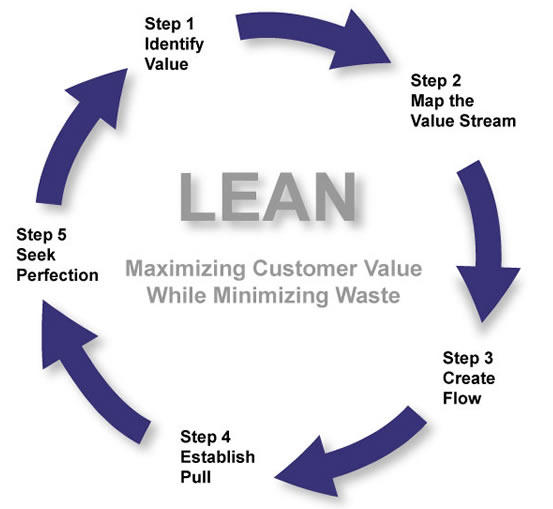Introduction
Throughout their lifecycles, projects go through a variety of phases, from the establishment of the original concept to a feasibility study and the stages of planning, implementation, and testing. In business, the creation and organisation of projects is primarily associated with cost estimates and budget planning. The financial aspect of any given project is one of the most critical determiners of its success. In particular, at the initial stages of preparation, projects are especially vulnerable when they lack a sufficient and thorough financial feasibility plan and budget. Apart from these factors, there are a number of other important issues that need to be taken into consideration by the individuals involved in project planning.
The focus of this paper is on a manufacturing management project that was implemented by Toyota. Today this approach is known as lean manufacturing; however, it used to be referred to as “just-in-time manufacturing”. This manufacturing approach is extremely complex and relies on the perfectly coordinated work of the production team, the supply chain, and the distributors. The major purpose of this project is the achievement of an extremely cost-effective manufacturing process by means of careful selection and planning of all of its component parts. First of all, this report will explore the selection of appropriate tools and techniques for the effective execution of the lean manufacturing approach. Secondly, it will provide an assessment of the financial feasibility of the project.
Toyota’s Lean Manufacturing: Project Overview
The Lean Enterprise Institute (2016) defines lean manufacturing as a concept that is focused on the maximisation of customer value accompanied by the minimisation of waste. In other words, the idea of lean manufacturing calls for a reduction of the resources used in production while maximising the value of the goods delivered to the customers. Ideally, production is directed at the achievement of zero waste and maximum customer value. Needless to say, this style of manufacturing is very demanding in terms of operations alignment.
One of the most world-renowned companies that employs lean manufacturing is Toyota. In fact, this approach is also known as the Toyota Production System (TPS), and it was initiated after the Second World War when Japan’s devastated economy forced the company, which was then operating with scarce resources, to reassess its production (Liker, 2004). The system is based on customer needs as the grounds for process management, especially when it comes to value-added activities. There are eight factors of production that must be completely eliminated in lean manufacturing: incorrect processing, overproduction, excess inventory, unnecessary movement, unused creativity of workers, waiting, defects, and unnecessary conveyance and transportation (Miller, Pawloski, & Standridge, 2010). These aspects are recognised by Toyota as types of waste. The basic framework designed to help establish the lean system is presented in Figure 1.

Tools and Techniques for the Project Execution
In order to put lean manufacturing into practice, Toyota’s project managers had to move the company’s primary focus from the optimisation of separate operations, assets, and technologies in a vertical manner to the establishment of a smooth horizontal flow of services and products across systems and technologies, from departments to consumers (Lean Enterprise Institute, 2016). The elimination of waste was the major priority. Toyota managed to eliminate waste throughout its operations and systems and thus achieved a kind of production with an easier information management system that consumed fewer resources and less space, capital, and time. The products are manufactured with fewer defects and at a much lower cost, which in turn results in a significant increase in the value and quality of the end products delivered to customers.
Toyota employed a wide range of tools and techniques in order to achieve all the benefits of lean manufacturing. A visual representation of some of the most important tools and techniques involved in Toyota’s lean manufacturing are presented in Figure 2.

As shown in Figure 2, the entire system is based on the creation of a stable flow of processes and operations that are maintained with the help of a wide scope of practices. Moving from the bottom of the house-shaped structure upwards, one first sees the tools of standardised work known as heijunka and kaizen. The former technique represents the stability of workloads and is supported by a motto that says, “Work like the tortoise, not the hare” (Liker & Meier, 2011, p. 9).
In practical terms, heijunka is the tool responsible for levelling the work in order to achieve a harmonious working process without the ups, downs, and peaks of activity in which errors are most likely. The second tool, kaizen, stands for ongoing improvement through constant learning and innovation (Lean manufacturing, 2016). In other words, the managers and leaders of Toyota believe that regardless of the effectiveness and smoothness of their processes, they can always be improved.
Furthermore, the just-in-time set of tools includes continuous flow, takt time (i.e., the range of consumer demand for Toyota’s products), and the pull system (i.e., the movement of materials and resources in accordance with the needs of the customers) (Liker & Meier, 2011). These three tools are designed to create and maintain a steady process of manufacturing in which the suppliers’ and producers’ performances are carefully coordinated with the consumers’ needs so that each service or product is delivered at the exact moment when it is needed by one of the parties (Liker & Meier, 2011).
This form of manufacturing can be quite risky when all sides are not working in complete agreement or when some kind of accident occurs. Indeed, the smallest disruption in such a system can cause a major and very costly failure of other operations. Toyota cannot afford accidents and therefore its operations are aligned and coordinated perfectly for the purpose of avoiding defects and waste.
Finally, the practices of jidoka are presented as one of the core pillars of Toyota’s “house”. These practices are responsible for the establishment of mistake-free manufacturing and include the division between practices and operations that can be controlled manually and those performed entirely by machines. In addition, it is critical for Toyota to ensure the ability of the machines to stop when an error is present and notify operators of the problem so that the challenge can be addressed right away without jeopardising any more operations, products, or practices (Lean manufacturing tools, 2016).
These are the primary tools that Toyota relies upon in order to manage its complex lean manufacturing system and achieve production without waste. There also exist a number of secondary tools such as value stream mapping, bottleneck analysis, right first time, and SMED, to name a few. In its entirety, the system requires a lot of control, assessment, and monitoring to work productively and flawlessly on a daily basis.
Financial Feasibility
The idea of lean manufacturing was introduced to Toyota when the company decided to ensure production with minimal waste. Since Toyota was one of the leading industry performers in the country at the time, it had the assets necessary to invest in this project. From the very beginning of the project planning, Toyota’s leaders and managers were aware that this would be a long-term investment and were prepared to wait for its results to start generating value (Liker, 2004).
The initial step of the lean production plan is the establishment of a simplified system. Toyota had to redesign its manufacturing completely, which required significant investment. However, the benefits of the reduced inventory and the levelled employee workloads came immediately; indeed, production became easier, the likelihood of errors decreased, and there was no need for excessive transportation and movement since no extra resources had to be managed. The major cost and threat to the project was the selection of suppliers and the creation of a new supply chain that would work perfectly within the system. In particular, the problem was that not all suppliers would agree to fit into the unique schedule of the company. However, the ones that did decide to collaborate with Toyota became partners for many years and have earned steady revenue from this beneficial system.

Conclusion
In conclusion, the lean manufacturing project is highly beneficial for the manufacturer because it ensures that production works flawlessly and all of its aspects function properly. Errors are detected right away, the cost-effectiveness of such manufacturing is maximised, and the waste is zero. The project requires investment in the form of financial capital, effort, commitment, dedication, and integrity, as well as logistics planning, customer segment analysis, and the careful selection of suppliers.
References
Lean Enterprise Institute (2016). What is lean?. Web.
Lean manufacturing. (2016). Working more efficiently. Web.
Lean manufacturing. (2015). Web.
Lean manufacturing tools. (2016). Lean manufacturing tools, principles, implementation. Web.
Liker, J. K. (2004). The Toyota way. Web.
Liker, J. K. & Meier, D. (2011). The Toyota way: Fieldbook. New York, NY: McGraw Hill.
Miller, G., Pawloski, J., & Standridge, C. (2010). A case study of lean, sustainable manufacturing. Journal of Industrial Engineering and Management, 3(1), 11-32.
Toyota production. (2016). Web.
Toyota’s production system (TPS). (2006). Web.
